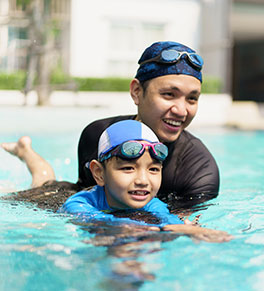Prevent drowning with basic water safety skills

Swimming lessons and water-safety training can be lifesaving at any age.
When the weather is warm, the glistening waters of California’s pools, beaches, lakes and streams beckon young and old to dive in and cool off. But the lack of water safety skills and simple precautions can result in a trip to the emergency room or even death.
An estimated 4,000 Americans die each year from unintentional drowning, according to the U.S. Centers for Disease Control and Prevention (CDC). In 2023, Orange County reported 54 drowning deaths, up from 43 in 2022.
Drowning is also the No. 1 cause of death for U.S. children ages 1 to 4 and a leading cause of fatalities for children ages 5 to 15, second only to motor vehicle crashes.
UCI Health emergency medicine specialist Dr. Isabel Algaze Gonzalez says a key factor in these deaths and the estimated 8,000 non-fatal U.S. drownings each year is the inability to swim or practice basic water safety skills.
“Drowning is preventable,” Algaze says. “Basic swimming skills and adult supervision — especially for children — can make a lifesaving difference.”
Drowning can occur quickly and quietly — and doesn't always happen the way people expect.
Little water needed
“A common misconception is that someone must be fully submerged or unconscious to be drowning,” notes Algaze, who also serves as medical director of the Catalina Island Medical Center emergency department, which is affiliated with UCI Health.
“In reality, drowning is a process. It can happen in just a few inches of water and doesn’t always involve dramatic splashing or cries for help.”
Although children are at high risk, more than 70% of U.S. drowning deaths are among people ages 21 or older, often related to boating accidents, alcohol use or lack of swimming ability, according to a CDC study.
"Understanding your own abilities and the limitations of your equipment — in both current and expected environmental conditions — is key to staying safe." Algaze explains.
Drowning prevention
Whether in a backyard pool or the ocean, simple steps can significantly reduce the risk of drowning. Algaze recommends the following:
- Ensure children learn basic water safety and swimming skills.
- Always supervise children closely when they are in or around water. Ideally, stay within arm’s reach — especially for young or inexperienced swimmers.
- Install fences around pools that separate the water from the house and play areas.
- Never leave a child alone near water, even for a moment.
- Avoid consuming alcohol while supervising children, swimming or boating.
- Learn cardiopulmonary resuscitation (CPR) and keep rescue equipment nearby.
- Use U.S. Coast Guard-approved life jackets when appropriate, especially on boats and in open water.
“Many boating-related drownings could be prevented by simply wearing a life jacket,” she says. “Roughly 85% of people who drown weren’t wearing one.”
Scuba and free diving safety
In remote or high-risk environments — such as scuba diving or free diving — preparation is key.
“Individuals with conditions like heart disease or seizure disorders should be evaluated by a physician before participating in diving or similar activities,” Algaze advises.
“It’s also important to have a dive buddy and a clear rescue plan in place.”
Training and awareness of environmental hazards, such as strong currents or cold water, are critical for anyone engaging in water-based recreation — particularly in wilderness or remote settings.
When someone is drowning
If you see someone who is having difficulty in the water, alert someone trained to respond, such as a lifeguard or another first responder.
People who are drowning tend to pull rescuers under the water in their panic and distress.
If possible, throw a flotation device for the person in distress to hold onto while waiting for help.
“We all want to enjoy the water — and we should,” says Algaze. “But with a little preparation and awareness, we can make these experiences safer for everyone.”
As the only Level 1 trauma center in Orange County, UCI Health — Orange, formerly known as UCI Medical Center, provides the most comprehensive emergency and specialist care in the region, 24 hours a day, seven days a week.
Related stories
- What to pack in a travel first-aid kit ›
- The ABC's of sunscreens ›
- Protect yourself from tick-borne infections ›
- Keep food-borne illnesses off the menu this summer ›




